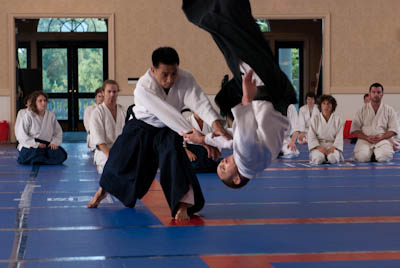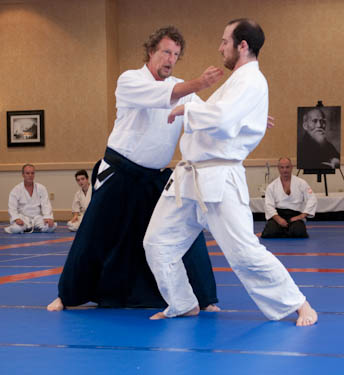Principles Of Aikido
It is not possible to cover here, or perhaps even in any number of books, all the principles of Aikido or even give great detail on what is mentioned. The interested reader is directed to the Bibliography for more information or for informed, respectful, discussion, to Aikido-L mailing list.
Ki
"you may not believe in Ki, but you sure as hell cultivate it"
Aikido makes extensive use of the concept of Ki. Aikido is one of the more spiritual martial arts and has been referred to as 'moving Zen'. The name Aikido can be translated as 'the way of harmony of Ki. Exactly what Ki. 'is' is a somewhat controversial issue.
Some believe that the physical entity Ki. simply does not exist. Instead, the spirit, the intention, the bio-physico-psychological coordination through relaxation and awareness are concepts being used in the teaching. These Aikidoka sometimes tend to frown upon the philosophical/spiritual aspect of Ki.
Other Aikidoka believe that Ki. does exist as a physical entity and can be transmitted through space. They, on the other hand, make use of concepts such as Ki. of the universe, extending Ki. etc.
The fact of the matter is that there is a large portion of Aikidoka who are still, and no doubt will continue be, on their 'quest for Ki.
Without doubt, this has been the most difficult question to write any kind of reasonably fair answer to. On the subject of the nature of Ki., perhaps more than in any other area of Aikido, the Aikidoka must find his or her own answer, whatever that may be. The last word on this subject will be left to the Doshu, Kisshomaru Ueshiba, the son of O Sensei:
"We may hear students say that `It is a feeling of some kind of energy coming forth from mind and body in harmony.' Or `It is a strange, vital power which appears unexpectedly at times from an unknown source.' Or `It is the sense of perfect timing and matched breathing experienced in practicing Aikido.' Or `It is a spontaneous, unconscious movement which refreshes mind and body after a good workout,' and so forth.
Each answer is valid in the sense that it is a true reaction gained through actual personal experience. And being a direct expression of a felt condition, it contains a certitude that cannot be denied. If this is so, the differences in responses is negligible, and the great variety attests to not only the difficulty in precisely defining Ki. but shows that the depth and breadth of Ki. defy coverage by a single definition." -- from "The Spirit of Aikido"
Entering (irimi)
"The difference between the living and the dead is timing."
Entering, or "irimi" is one of the basic techniques of Aikido and is closely related to "blending" with an attacker. At a basic level, irimi is a movement which looks like a sliding step toward or into an opponent's attack. Aikido thinks of most movement as being circular or spiraling in nature; irimi brings a person "into" the circle of movement, so that the energy of the attack can be directed along the circular plane - much like catching a Frisbee on your finger, letting the circular energy 'spin' around the finger and then sending it on its way in the same, or an alternate direction, with a minimum of effort.
The concept of entering emphasizes the importance of placing oneself inside the "danger radius" of a partner's attack. Imagine a boxer's punch. The punch has gathered most of its power and effectiveness at or near the full extent of the boxer's arm. Beyond the reach of the arm there is little danger or threat. Similarly, inside the full extent of the arm the moving fist has developed very little energy, and again poses little or no threat. Several things may be substituted for the boxer's punch: any strike with a hand, knife, sword or staff, for example.
Ukemi
Good Ukemi is moving through a technique looking for an opportunity to crunch (oops, I meant educate) your opponent (oops, I meant partner) for trying to do such a nasty thing to your arm/body.

Ukemi may be described as the art of receiving a technique. The practice of ukemi involves rolls and other breakfalls. Here are a few reasons why we practice ukemi in Aikido, and why it is such an important part of our Aikido training:
1. To stay safe. That is, not only to avoid injury in that confrontation, but to be aware of what is going on throughout the whole confrontation (encounter) and therefore be able to find and respond to openings and, perhaps, to escape.
2. To experience the throw. Part of the learning process must be to understand what the *other* side of the encounter is - what does it feel like to be tied up in a particular technique? Also, to observe the other person's technique, particularly if nage is a senior student or teacher. Being able to take ukemi means allowing the detachment necessary to "observe" (with the body and mind).
2.a. To learn to listen with your body. To throw well requires sensitivity to your partner. Often we are so caught up in the active role of nage that we forget to be receptive to our partner and move in a way that harmonizes with uke. By being uke we get a chance to emphasize the receptive aspects of body movement (though that is not all there is to it). Hopefully, by emphasizing receptivity half of the time you improve your receptivity the other half of the time.
3. To assist your partner to learn. Being a good uke means maintaining the connection with nage, and allowing nage to experience that connection and to really experience the technique. Being a good uke allows nage to perform the technique without worrying about uke being injured.
4. To condition the body. Taking good ukemi requires a lot of work; much emphasis is placed on staying connected, staying flexible and staying aware.
Saotome Sensei says in his book "The Principles of Aikido":
"Good ukemi training will allow you to see the future truly
because your vision will be based on observation and intuition,
rather than an arbitrary decision made in advance of the evidence.
Good ukemi represents the same wisdom as that of the fisherman
who through long experience can sense what the coming weather
will be."
Atemi

When I need to I hit people with the largest weapon I can find: the Earth.
Atemi, literally, means to strike the body. A simple explanation of Atemi is that they are strikes. Some people insist on more rigorous definitions such as only strikes to pressure points. One purpose of Atemi is to distract your partner, so that they focus on your hand, or their pain, rather than their grasp. This can make it easier to move. In this context, you could regard Atemi as a "Ki. disturbance".
Atemi, on some interpretations, need not be an actual strike, since what matters is the effect on uke, that is, the upsetting of uke's physical and psychological balance, facilitating the application of technique. Some claim that the best way to ensure such unbalancing is to deliver a real strike, especially where there is potential for strong resistance.
Still others claim that Atemi involves "projecting Ki." toward uke, where this involves something above and beyond merely provoking a sort of startle reflex or response to the physical strike (or threat thereof).
Some feel Atemi is important in the actual accomplishment of waza rather than being independent waza in and of itself. This is a personal feeling. This distinguishes Aikido (in the opinion of some) from striking arts where the Atemi is the focus.
What does it mean to 'move off the line'?
"Absence of body is better than presence of mind"
The energy of any attack flows from one point to another, usually from an attacker to his or her intended victim. The line that connects these two points is called the line of attack. For example, the energy in the boxer's punch flows (via his fist) outwardly from his body towards his opponent. This is the line of attack. Once an attack is committed, it is very difficult, if not impossible, to change the course of the attack. (An excellent example of this is the flying kick in Karate: once the attacker has left the ground, there is very little that can be done to change the course of the attack.) To 'move off the line' is to move off of the line of attack at or after the point at which the attack is committed, into an area or zone of safety.
Center/hara/haragei
"Flow with whatever may happen and let your mind be free: Stay centered by accepting whatever you are doing. This is the ultimate." -Chuang-Tzu
One's center is just that - the physical and martial-arts "middle" of the body. Located in the abdomen ("hara"), it serves as the source/focus of Ki./energy and as one's balance point when executing techniques. Try lifting something directly in front of you, then try lifting the same object when it's off to one side - it's much easier when it's "centered," right? Maintaining an awareness of (and "connection" to) your and your training partner's centers makes just that kind of difference in the ease and flow of Aikido.
Extension
"If you hit someone with a chair and extend your Ki. through the chair, it's an Aikido technique."
Just as it is important to "remain centered," it is important to "extend" in Aikido. Many techniques are facilitated by "extending Ki." or "extending energy" during their execution. Physically and psychologically, this helps counter the tendency of many people to contract and keep their arms and legs close to their bodies, because Aikido is generally practiced with large, sweeping movements.